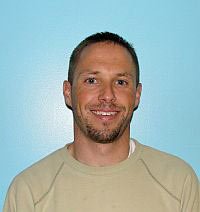
The College of Engineering has selected Jeremy Shannon, principal lecturer in the Department of Geological and Mining Engineering and Sciences (GMES), for this week’s Deans’ Teaching Showcase. Dean Janet Callahan selected him for teaching excellence in a field course.
Shannon joined GMES as a lecturer in 2007. He teaches a variety of courses throughout the year including Understanding the Earth (GE2000), a large course that is taken by many non-major students. Department Chair Aleksey Smirnov (GMES) says “Dr. Shannon provides a vital contribution to GMES undergraduate instruction and advising. He is an outstanding instructor and an impactful and trusted mentor.”
One of Shannon’s favorite courses is Field Geophysics (GE3900), a summer, a five-credit course required for Geological Engineering, Geology, and Applied Geophysics majors. Most geoscience programs only require a field geology course, so this class provides an extremely unique, hands-on experience for GMES students. The five-week-long class is set up like a consulting job with weekly projects. Each project uses a different geophysical technique, or a combination thereof, with specified goals. As one student put it, “Jeremy had an innate ability to connect with us all, especially on field trips. He utilized more field visits than any other professor I had at Tech. This gave me real-life scenarios and examples to help cement concepts I had learned in the classroom.”
A typical week involves fieldwork, the reduction, interpretation and modeling of data, and a final written report or oral presentation. Shannon worked for a few years in environmental consulting and likes that he can share with students his own experiences that mimic the format of this class, especially the report writing. This class offers one of the best opportunities in the GMES curriculum for practice in scientific writing, an invaluable skill that will translate directly for students that either choose employment or decide on graduate school. A recent alumnus observed that Shannon made sure the students also “focused on the hard work that occurred back in the classroom completing the reports to improve students’ report writing skills. Jeremy had very high standards for the reports. His resolve in consistent writing and proper formatting for all reports significantly influenced my use of proper documentation, even today.”
Shannon is an MTU alumnus and took the Field Geophysics class as an undergraduate in the summer of 1992. He was honored to take over the class in 2007 from his former professor and mentor Dr. Jimmy Diehl, who taught it for 25 years. He has continued and built upon this legacy to deliver a unique field experience to GMES students. In particular, Shannon has proactively worked to upgrade the geophysical equipment which is typically expensive. Over the last several years, with the help of departmental, alumni, and C2E2 funding, new seismic refraction and ground-penetrating radar systems were purchased. Other equipment includes magnetometers, electrical resistivity meters, electromagnetic instruments, and one precious gravity meter. And he makes using the equipment fun. Another student said, “Jeremy helps students to see the joy in fieldwork. He makes it exciting to see seismic waves be recorded by a geophone, or he encourages us to be patient in aligning the gravimeter.”
The class projects typically target objects or structures within tens of meters below the surface. The projects include determining depth to bedrock and water table, mapping contacts between different rock types, or locating buried metallic and non-metallic objects on the site of a Calumet & Hecla stamp mill in Lake Linden. About five years ago, Shannon collaborated with the Michigan DNR and had the class perform geophysical surveys to delineate a buried bedrock valley near McLain State Park. There is no definite surface expression of the valley as it is filled with glacial till, but a gravity survey showed that the ~3 km wide and 200 meters deep valley trends to the north through a portion of the park. The absence of bedrock near the surface where the valley is located is precisely the location where significant beach erosion is taking place. These results became part of the decision-making process, which resulted in the recent restructuring of the park layout.
Dean Callahan summarizes: “Shannon’s dedication to continually improve the field course provides a unique learning environment for our students in which they develop skills that they will use throughout their careers. He is very deserving of this recognition.”
Shannon will be recognized at an end-of-term luncheon with other showcase members, and is also a candidate for the CTL Instructional Award Series (to be determined this summer), recognizing introductory or large-class teaching, innovative or outside the classroom teaching methods, or work in curriculum and assessment.
Written by Aleksey Smirnov, Chair of Geological and Mining Engineering and Sciences.